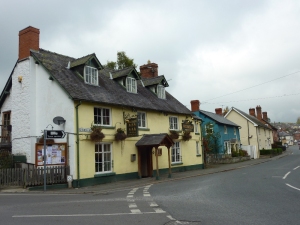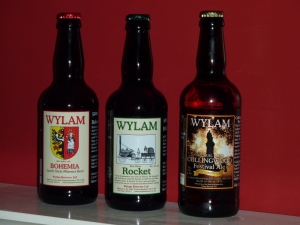Bishop’s Castle is a small town, built on a hill deep in rural Shropshire, not far from the Welsh border. It derives its name from the castle built there in the 12th century by the Bishop of Hereford.
This is a brewery town, a fact openly acknowledged by the tuns which sit proudly beneath the town boundary signs on the road sides (see above).
Despite this being really a very small town, it boasts three Good Beer Guide pubs and two breweries, one at the bottom of the hill, and one at the top. At the bottom of the hill is the Six Bells Brewery, located at the back of the Six Bells pub, and at the top of the hill is the legendary Three Tuns brewery, next door to the Three Tuns pub. I’ll return to the Three Tuns in the next instalment, but for now, I’m going to concentrate on the Six Bells.
The Six Bells Brewery was re-opened (or rather, a new brewery was opened with the same name) in 1997, after having been closed for about 90 years. The man behind this welcome move was Neville Richards, landlord of the Six Bells pub, and known universally as ‘Big Nev’.
I visited the Six Bells on a Friday evening early in October. Faced with doors to two different bars, I randomly plumped for the left hand one (I was told later that this was the ‘posh’ bar). The bar is small and filled with tables and chairs, giving little room to move. It was full, too. This is usually a good sign for a pub so I made my way to the bar. In this, the posh side of the pub, the bar is small, but three hand pumps were available, each dispensing a Six Bells brew. I had the choice of Cloud Nine, Supper and Noggin.
I had already sampled Cloud Nine elsewhere. I had found it to be a light, gently hoppy beer. Very drinkable and at 4.2%, quite acceptable as a session ale.
I opted first for the Supper, a 3.6% bitter. This is very good. The mouthfeel is smooth, and there is a tiny hint of cream. Malty flavours are accented by a small wisp of toffee. The aftertaste is long, and the taste fades to caramel, which is always pleasing.
Next, I tried Noggin. Another bitter, stronger this time at 4.1%, the flavour is far more pronounced. Hoppy and malty notes predominate with a distinct throat rasping huskiness that makes me think of granary bread, and that this beer really should be doing me some good. Whilst I marked Noggin slightly down from Supper, I would still be happy to drink this beer at any time.
The clientele in the pub was very open and friendly. At first, Lady A and I could not find anywhere to sit, until a couple of young lads shuffled up to make room for us. They were both somewhat into their cups, but remained pleasant and cheery. ‘Everyone’s friendly here,’ said one of them to me, slurring confidentially. ‘I mean look at us! We’re friendly and we’re not even from here!’
Although I only had two beers from the Six Bells itself, I had the opportunity to sample some other Six Bells brews whilst in the area. In the Admiral Benbow in Shrewsbury, I spotted Six Bells Benbow IPA. At 3.6%, I’m not quite sure how this qualifies as an IPA, and I found it rather under-tasty. Slightly bitter, slightly hoppy, but not terribly exciting.
Also on the bar at the Admiral Benbow was Bottom, a 4.3% brew that I presumed was a golden ale, but it’s described on the pump clip as ‘A Midsummer Night’s Ale’, hence the Shakespearean reference, I guess. It’s a very pale yellow in colour, almost greenish. This beer is light and noticeably sweet, though the sweetness fades midtaste and is replaced by a hoppy finish and a good bitter aftertaste.
A few days later, I saw Six Bells Castle Bravo on the bar in the Castle Inn in Ludlow. I opted for half a pint, as I usually do when trying a beer for the first time. Castle Bravo is a 4.7% bitter, and a dark orange in colour. First impressions are that this beer is heavily spiced. I was fairly sure that the main added flavour was cinnamon, but there was something else, something green and earthy. I have tasted something similar in nettle beer. So is that what the other ingredient was? Nettles? I don’t know, all I can report is that it’s overdone, and the cinnamon and whatever-it-is do not go well together. I’m afraid Castle Bravo is fairly awful, and unusually for me, I didn’t finish it.
On the whole, then, Six Bells beers left a favourable impression on me. I don’t expect to enjoy every beer I taste, and I’m sure there are people out there who will stand in Castle Bravo’s corner and fight for it. And that’s how things should be. Next outing, I’ll walk up the hill and sample beers from the Three Tuns Brewery.
Words and images are my copyright, please respect that. All you have to do is ask. Thank you.











